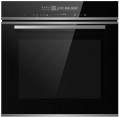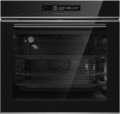Cooking temperature
The cooking temperature range allows you to understand which special tasks are subject to the oven. The lower temperature from which the oven starts heating, usually, is in the range of +30 to +50 ˚C. So, for example, the minimum heating temperature at
+30 ˚C allows you to defrost products. Models with a minimum of
40 ˚C and
50 ˚C allow you to heat ready meals, heat tableware (before serving), dry crackers, etc.
Number of modes
The number of cooking modes provided in the design of the oven. In this case, the cooking mode means the general opertaion mode — for example, “heating”, “heating + convection”, etc. Accordingly, this indicator strongly depends on additional equipment (see "Features"). However, even in similar models, the number of modes may be different. In general, the
more cooking modes, the more cooking options, the easier it will be to choose the optimal mode for a specific situation.
Features
Among the ovens features, one can single out the basic ones inherent in most devices (
gas control,
auto ignition,
thermostat, timer,
auto switch-off,
child lock), and top-level features that are relevant for devices of the highest category (
control via Internet,
built-in video camera,
TFT display). More about them:
— Gas control. Thermoelectric system designed to protect against gas leakage. If the flame is accidentally extinguished, the gas supply to the chamber is immediately stopped. The gas control usually includes a thermocouple (to determine the presence or absence of a flame) and a gas blocking device.
— Auto ignition. A system that provides automatic ignition of gas simultaneously with the start of its supply. The user does not need to use matches or a lighter, press a separate button, etc.: the gas ignites immediately when the handle is turned. Found only in models with appropriate heaters (see "Oven").
— Thermostat. A device that maintains a predetermined temperature in the oven.
— Timer. A device that provides a countdown time and allows you to control the cooking process precisely. After the set time has elapsed, the timer, usually, beeps, and in some models, i
...t also turns off the heating. Timers can be either mechanical or electronic; the first one is simple and inexpensive, and the second one is more accurate and better combined with additional features (for example, auto switch-off).
— Auto switch-off. In this case, we are talking about a function that provides automatic shutdown of the oven according to the timer (see below); the timer itself does not imply auto-off, so if such an ability is important, you should choose a model where it is directly stated. Also, auto switch-off can be provided as a protective system that prevents overheating — such automation turns off the oven if no commands have been received from the user for a long time or when the temperature rises critically.
— Control via Internet. The specific control method may be different: some models use an application that needs to be installed on a smartphone or tablet, while others use a regular web page that can be opened in any browser. These details should be specified separately. Anyway, this function allows you to access control from anywhere in the world where there is access to the World Wide Web. For example, in the morning you can load food for a dish into the oven, and when you leave work, launch a cooking programme via the Internet, and get a ready-made hot dish by the time you return home. Also, note that such control usually allows not only to give commands but also to receive notifications from the oven. In particular, the device can report the progress of the programme, readiness, various problems, etc.
— Video camera. The presence of a built-in camera for more detailed control of the preparation of the dish. The user can visually control the cooking process without opening the oven door. Most often, the built-in camera transmits video via a wireless Wi-Fi connection. As a pairing device, you can use both a computer with a laptop and a tablet/smartphone. Of course, on a mobile/computer device, you will need to install proprietary software. The video camera is especially relevant in cases where the oven is used to prepare complicated meals. Regular control, without disturbing the temperature regime due to the opening of the door, minimizes the risk of food spoilage.
— TFT display. The oven has its TFT display. In this case, we mean a screen that does not consist of segments but pixels and is suitable for displaying various types of data: numbers, text, graphic symbols, pictures, etc. A wide variety of information can be displayed on the TFT display, which makes the operation of the oven more convenient. However, this variety is only relevant for advanced models with an abundance of functions, so the presence of such a screen is usually a sign of a premium oven.
— Child lock. In modern ovens, it can be done in different ways. So, in some models, you can block the oven door — so that a curious little child cannot open it during cooking and get burned. In other devices, a control panel lock is also provided — thanks to it, the baby will not be able to turn on/off the device or change the cooking mode. Child lock is unlocked in a non-obvious way accessible to an adult but not to a child — for example, by simultaneously pressing two buttons.Energy class
This indicator characterizes how economically the oven consumes electricity. Initially, classes were marked in Latin letters from
A(highest) and further down as they went down. Later improved classes
A +,
A ++, etc. appeared (the more pluses, the better). More energy-efficient models are more expensive but can pay for themselves in the process of use, especially if you have to cook often and in large quantities.
Connected load
The electrical power consumed by the oven during operation, in other words, the power that must be supplied to the oven so that it can work normally. This parameter determines not only the total energy consumption (and, accordingly, the amount of electricity bills) but also the specifics of the power supply: with a power consumption of several kilowatts, a conventional outlet may not be suitable, and the wiring must be quite reliable.
Note that it is customary to indicate the connection power only for electric models (see "Oven"), as well as for gas devices with electric grills.
Dimensions (HxWxD)
In the case of ovens, the dimensions determine not only the sizes, but also the conditional form factor and the possibility of installing models. Dividing by height, the devices can be
compact(low) for installation in hanging cabinets and
full-sized — classic ovens for installation under the countertop. As for the width, in addition to
standard models of 60 cm, there are
narrow (45 cm) and
wide (90 cm) models to interact with similar wide hobs.

